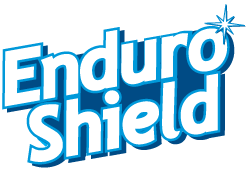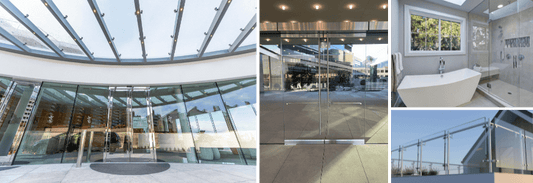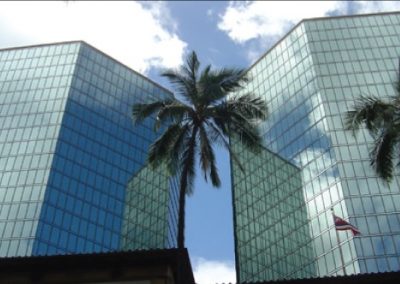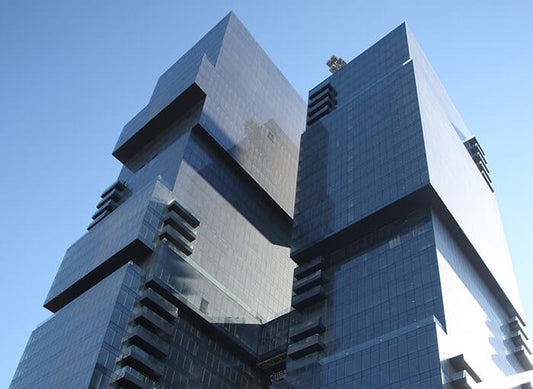Self Cleaning Glass vs Easy Clean Glass Coatings: What’s the Difference?
While the terms "self-cleaning glass" and "easy-clean coatings" are often used interchangeably, they refer to two different approaches to reducing glass maintenance. Self-cleaning glass typically uses a coating that contains titanium dioxide, which reacts with UV light to break down organic dirt so it can be washed away by rain. Easy-clean coatings, on the other hand, work by creating a smooth, water-repellent surface that helps prevent dirt and grime from sticking in the first place. Self-cleaning glass relies on environmental factors like sunlight and rainfall to function, whereas easy-clean coatings are designed to make routine cleaning easier and are often more versatile across different types of glass.

The application of low maintenance coatings to exterior glass surfaces, typically applied to surface #1, is becoming increasingly common in architectural and commercial developments. These glass coatings serve two primary functions:
- Reducing the frequency of manual glass cleaning, and
- Protecting glass from staining, etching, and long-term surface degradation caused by contaminants such as cement slurry, lime, mineral deposits, and atmospheric pollutants.
As a result, architects and construction professionals are increasingly specifying such glass coatings in glazing schedules.
EnduroShield addresses the growing demand for easy clean glass solutions by offering advanced hydrophobic glass coatings that provide long term durability while significantly reducing maintenance. Utilised by leading glass manufacturers, this technology has been implemented across a wide range of architectural and industrial projects globally.
It is important to distinguish EnduroShield from the commonly used, but often misunderstood term, "self-cleaning glass."
Understanding Self Cleaning Glass Technologies
While some self cleaning window treatments offer tangible benefits, they also come with performance limitations. Two types of coatings are widely marketed under the label "self-cleaning glass": hydrophilic coatings and superhydrophobic coatings
Hydrophilic Coatings
Hydrophilic glass coatings, typically incorporating titanium dioxide (TiO₂), function via photocatalytic mechanisms to break down organic contaminants. When exposed to ultraviolet (UV) solar radiation, TiO₂ catalyzes the decomposition of organic matter. Simultaneously, the hydrophilic surface promotes even water spreading, forming a thin film that rinses away the loosened debris. These surfaces exhibit a very low water contact angle (typically <15°), helping reduce streaking and water marks.
This mechanism may be advantageous in environments where condensation control is important, as the water spreads evenly rather than forming droplets.
Limitations of Hydrophilic Coatings:
- Cleaning Self Cleaning Glass: While effective against organic contaminants, these coatings do not remove inorganic residues like dust, mineral deposits, or hard water stains. Their functionality depends on consistent UV exposure and natural rainfall, making them unsuitable for shaded areas or dry climates. In addition, accumulations such as fallen leaves on horizontal glass roofs can block UV radiation and water flow, rendering the self-cleaning mechanism ineffective.
- Installation Constraints: Most manufacturers specify a minimum installation angle, typically 10 - 15° from horizontal, to enable effective water runoff. Hydrophilic coatings are less effective on vertical glazing, where water does not sheet uniformly. Furthermore, silicone sealants or their vapours can interfere with the coating's photocatalytic function, forming a film that prevents activation.
- Optical Appearance: Hydrophilic coatings tend to be more reflective than standard glass, which can make surface scratches and imperfections more visible.
- Limited Options: Typically offered on standard clear float glass and are rarely available on low-iron glass, body-tinted glass, solar control glazing, laminated substrates, or other non-standard glass types. Dual coatings, such as hydrophilic coatings on surface #1 combined with low-emissivity (Low-E) or solar control coatings on surface #2, are also uncommon.
Hydrophilic coatings are therefore not recommended for interior use or in shaded exterior locations.
Additional Considerations:
- The surface must be flushed with water regularly to effectively remove contaminants.
- Inorganic residues, such as hard water stains and salt deposits, remain on the surface and are not broken down by the coating.
- These coatings are not suitable for marine environments, where salt spray quickly diminishes performance.
- The term “self-cleaning” can be misleading, as these surfaces still require periodic maintenance to preserve optical clarity and functional integrity.
Although field-applied hydrophilic coatings are available, their application presents technical challenges, and durability is generally limited to 3–5 years under standard environmental conditions.
In summary, while hydrophilic coatings may be effective in specific applications, particularly where there is consistent UV exposure and rainfall, their broader adoption remains limited due to performance constraints and misalignment between marketing claims and real-world functionality.
Superhydrophobic Coatings
Superhydrophobic coatings operate in contrast to hydrophilic ones. Rather than encouraging water to spread, superhydrophobic coatings repel water, with contact angles typically above 150°. Water beads and rolls off, collecting loosely adhered particles, a phenomenon known as the Lotus Effect.
Limitations of Superhydrophobic Coatings:
- Optical Limitations: Superhydrophobic coatings can introduce surface haze or visual distortion, making them unsuitable for high-clarity architectural glazing.
- High Cost: These coatings are often expensive, due to complex formulations and precise application requirements.
- Application Sensitivity: They require careful surface preparation and controlled application environments to perform reliably.
- Durability Issues: Many formulations degrade under environmental stress and require frequent reapplication.
Why Specify EnduroShield Instead Of “Self Cleaning Glass”?
EnduroShield provides a high-performance, versatile alternative to hydrophilic and superhydrophobic coatings. Specifically designed for exterior glass applications, EnduroShield creates a durable, transparent barrier that imparts hydrophobic properties to the surface. By reducing surface energy, it minimises the adhesion of contaminants and facilitates easier cleaning, similar to non-stick cookware.
Key Benefits of EnduroShield:
- Protects glass during construction from cement slurry, lime, and chemical damage
- Reduces the frequency of cleaning
- Keeps glass cleaner between cleaning cycles compared to untreated glass
- Shields glass from staining, etching, and mineral damage
- Suitable for all types of exterior glazing, including:
- Laminated glass
- Insulating glass units (IGUs) with solar control coatings on Surface #2
- Glass railings, such as those used on balconies
- Ideal for horizontal glass roofs, vertical façades, and areas with silicone sealants or coastal exposure
- Trusted by leading global glass manufacturers
- Backed by a 10-year performance warranty
EnduroShield has been independently tested by TÜV Rheinland and certified to perform for over 10 years under real-world conditions. The coating passed stringent testing for:
- UV resistance
- Chemical resistance
- Temperature shock
- Mechanical durability
- Easy-clean performance
Conclusion
EnduroShield offers easy-to-clean glass protection that can be confidently specified as a superior alternative to traditional self-cleaning glass technologies. It delivers long-lasting performance against a wide range of organic and inorganic contaminants, offering enhanced durability, improved visual clarity, and reduced maintenance requirements, making it the preferred choice for forward-thinking architects, developers and home owners.




